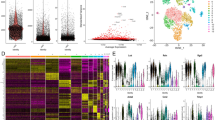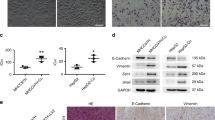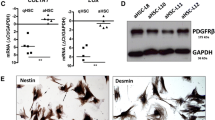Abstract
Purpose
Hepatic stellate cells (HSCs) transdifferentiate to become extracellular matrix-producing myofibroblasts during liver injury. Myofibroblasts can also promote invasion and metastasis of hepatocellular carcinoma (HCC). In this study, we determined gene expression changes in two different models of HSC activation, induction-activated HSCs (iHSCs) and culture-activated HSCs (cHSCs).
Methods
Hepatic stellate cells were isolated by density centrifugation and exposed to conditioned medium (CM) from the rat HCC cell line C5F, and fetal bovine serum (FBS). Expression of 27,100 genes in quiescent HSCs, cHSCs and iHSCs was analyzed by microarray and was confirmed on a subset of genes by real-time RT-PCR and Western blot.
Results
One thousand nine hundred sixty-seven genes were differentially expressed in cHSCs and iHSCs, including genes that encode proinflammatory factors, adhesion molecules, cell surface receptors, signaling transduction and immune factors such as Il1a, Vcam1, Ccl6, Ilr7, PRAP, osteopontin, Gp39, Raf1, Rac2, Adam17, Wnt6, MMP-9, and Cfd. C5F-CM-induced activation only partially reproduced the gene expression changes observed during FBS culture activation. iHSCs showed specific gene expression, suggesting that HCC cells can specifically induce HSC activation.
Conclusions
Induction-activated HSCs’ gene expression patterns were partially similar to and different from that of cHSCs. iHSCs might play an important role in invasion and metastasis of HCC. This study provided theoretical foundations for investigating the biology of HSCs in HCC.






Similar content being viewed by others
Abbreviations
- HSCs:
-
Hepatic stellate cells
- ECM:
-
Extracellular matrix
- α-SMA:
-
α-Smooth muscle actin
- FBS:
-
Fetal bovine serum
- qHSCs:
-
Quiescent HSCs
- cHSCs:
-
Culture-activated HSCs
- iHSCs:
-
Induction-activated HSCs
- HCC:
-
Hepatocellular carcinoma
References
Adegboyega PA, Ololade O, Saada J, Mifflin R, Di Mari JF, Powell DW (2004) Subepithelial myofibroblasts express cyclooxygenase-2 in colorectal tubular adenomas. Clin Cancer Res 10:5870–5879
Aishima S, Nishihara Y, Iguchi T, Taguchi K, Taketomi A, Maehara Y, Tsuneyoshi M (2008) Lymphatic spread is related to VEGF-C expression and D2-40-positive myofibroblasts in intrahepatic cholangiocarcinoma. Mod Pathol 21:256–264
Bataller R, Brenner DA (2005) Liver fibrosis. J Clin Invest 115:209–218
De Minicis S, Seki E, Uchinami H, Kluwe J, Zhang Y, Brenner DA, Schwabe RF (2007) Gene expression profiles during hepatic stellate cell activation in culture and in vivo. Gastroenterology 132:1937–1946
De Wever O, Demetter P, Mareel M, Bracke M (2008) Stromal myofibroblasts are drivers of invasive cancer growth. Int J Cancer 123:2229–2238
Desmoulière A, Guyot C, Gabbiani G (2004) The stroma reaction myofibroblast: a key player in the control of tumor cell behavior. Int J Dev Biol 48:509–517
Dimanche-Boitrel MT, Vakaet L Jr, Pujuguet P, Chauffert B, Martin MS, Hammann A, Van Roy F, Mareel M, Martin F (1994) In vivo and in vitro invasiveness of a rat colon-cancer cell line maintaining E-cadherin expression: an enhancing role of tumor-associated myofibroblasts. Int J Cancer 56:512–521
Enzan H, Himeno H, Iwamura S, Onishi S, Saibara T, Yamamoto Y, Hara H (1994) Alpha-smooth muscle actin-positive perisinusoidal stromal cells in human hepatocellular carcinoma. Hepatology 19:895–903
Faouzi S, Lepreux S, Bedin C, Dubuisson L, Balabaud C, Bioulac-Sage P, Desmoulière A, Rosenbaum J (1999a) Activation of cultured rat hepatic stellate cells by tumoral hepatocytes. Lab Invest 79:485–493
Faouzi S, Le Bail B, Neaud V, Boussarie L, Saric J, Bioulac-Sage P, Balabaud C, Rosenbaum J (1999b) Myofibroblasts are responsible for collagen synthesis in the stroma of human hepatocellular carcinoma: an in vivo and in vitro study. J Hepatol 30:275–284
Futakuchi M, Ogawa K, Sano M, Tamano S, Takeshita F, Shirai T (2002) Suppression of lung metastasis by aspirin but not indomethacin in an in vivo model of chemically induced hepatocellular carcinoma. Jpn J Cancer Res 93:1175–1181
Guirouilh J, Castroviejo M, Balabaud C, Desmouliere A, Rosenbaum J (2000) Hepatocarcinoma cells stimulate hepatocyte growth factor secretion in human liver myofibroblasts. Int J Oncol 17:777–781
Honda M, Kawai H, Shirota Y, Yamashita T, Takamura T, Kaneko S (2005) cDNA microarray analysis of autoimmune hepatitis, primary biliary cirrhosis and consecutive disease manifestation. J Autoimmun 25:133–140
Hong S, Park KK, Magae J, Ando K, Lee TS, Kwon TK, Kwak JY, Kim CH, Chang YC (2005) Ascochlorin inhibits matrix metalloproteinase-9 expression by suppressing activator protein-1-mediated gene expression through the ERK1/2 signaling pathway: inhibitory effects of ascochlorin on the invasion of renal carcinoma cells. J Biol Chem 280:25202–25209
Jiang F, Parsons CJ, Stefanovic B (2006) Gene expression profile of quiescent and activated rat hepatic stellate cells implicates Wnt signaling pathway in activation. J Hepatol 45:401–409
Kellermann MG, Sobral LM, da Silva SD, Zecchin KG, Graner E, Lopes MA, Nishimoto I, Kowalski LP, Coletta RD (2007) Myofibroblasts in the stroma of oral squamous cell carcinoma are associated with poor prognosis. Histopathology 51:849–853
Lau DT, Luxon BA, Xiao SY, Beard MR, Lemon SM (2005) Intrahepatic gene expression profiles and alpha-smooth muscle actin patterns in hepatitis C virus induced fibrosis. Hepatology 42:273–281
Liu C, Gaça MD, Swenson ES, Vellucci VF, Reiss M, Wells RG (2003) Smads 2 and 3 are differentially activated by transforming growth factor-beta (TGF-beta) in quiescent and activated hepatic stellate cells. Constitutive nuclear localization of Smads in activated cells is TGF-beta-independent. J Biol Chem 278:11721–11728
Maggard M, Meng L, Ke B, Allen R, Devgan L, Imagawa DK (2001) Antisense TGF-beta2 immunotherapy for hepatocellular carcinoma: treatment in a rat tumor model. Ann Surg Oncol 8:32–37
Masamune A, Kikuta K, Watanabe T, Satoh K, Hirota M, Shimosegawa T (2008) Hypoxia stimulates pancreatic stellate cells to induce fibrosis and angiogenesis in pancreatic cancer. Am J Physiol Gastrointest Liver Physiol 295:G709–G717
Musso O, Théret N, Campion JP, Turlin B, Milani S, Grappone C, Clément B (1997) In situ detection of matrix metalloproteinase-2 (MMP2) and the metalloproteinase inhibitor TIMP2 transcripts in human primary hepatocellular carcinoma and in liver metastasis. J Hepatol 126:593–605
Neaud V, Faouzi S, Guirouilh J, Le Bail B, Balabaud C, Bioulac-Sage P, Rosenbaum J (1997) Human hepatic myofibroblasts increase invasiveness of hepatocellular carcinoma cells: evidence for a role of hepatocyte growth factor. Hepatology 26:1458–1466
Nhieu JT, Brochériou I, Préaux AM, Mallat A, Cherqui D, Zafrani ES, Mavier P (1998) Myofibroblasts and hepatocellular carcinoma: an in vivo and in vitro study. J Hepatol 29:120–128
Rockey DC, Boyles JK, Gabbiani G, Friedman SL (1992) Rat hepatic lipocytes express smooth muscle actin upon activation in vivo and in culture. J Submicrosc Cytol Pathol 24:193–203
Schmitt-Gräff A, Krüger S, Bochard F, Gabbiani G, Denk H (1991) Modulation of alpha smooth muscle actin and desmin expression in perisinusoidal cells of normal and diseased human livers. Am J Pathol 138:1233–1242
Siegmund SV, Seki E, Osawa Y, Uchinami H, Cravatt BF, Schwabe RF (2006) Fatty acid amide hydrolase determines anandamide-induced cell death in the liver. J Biol Chem 281:10431–10438
Surowiak P, Murawa D, Materna V, Maciejczyk A, Pudelko M, Ciesla S, Breborowicz J, Murawa P, Zabel M, Dietel M, Lage H (2007) Occurence of stromal myofibroblasts in the invasive ductal breast cancer tissue is an unfavourable prognostic factor. Anticancer Res 27:2917–2924
Svegliati-Baroni G, De Minicis S, Marzioni M (2008) Hepatic fibrogenesis in response to chronic liver injury: novel insights on the role of cell-to-cell interaction and transition. Liver Int 28:1052–1064
Terada T, Makimoto K, Terayama N, Suzuki Y, Nakanuma Y (1996) Alpha-smooth muscle actin-positive stromal cells in cholangiocarcinomas, hepatocellular carcinomas and metastatic liver carcinomas. J Hepatol 24:706–712
Tsuneyama K, Kouda W, Nakanuma Y (2002) Portal and parenchymal alterations of the liver in idiopathic portal hypertension: a histological and immunochemical study. Pathol Res Pract 198:597–603
Tuchweber B, Desmoulière A, Bochaton-Piallat ML, Rubbia-Brandt L, Gabbiani G (1996) Proliferation and phenotypic modulation of portal fibroblasts in the early stages of cholestatic fibrosis in the rat. Lab Invest 74:265–278
Acknowledgments
We thank Boao Biochip Co Ltd, Beijing, China, for help in cDNA microarray construction.
Conflict of interest statement
We declare that we have no conflict of interest.
Author information
Authors and Affiliations
Corresponding author
Additional information
Y. Xia and R. Chen contributed equally to this study.
Electronic supplementary material
Below is the link to the electronic supplementary material.
Rights and permissions
About this article
Cite this article
Xia, Y., Chen, R., Song, Z. et al. Gene expression profiles during activation of cultured rat hepatic stellate cells by tumoral hepatocytes and fetal bovine serum. J Cancer Res Clin Oncol 136, 309–321 (2010). https://doi.org/10.1007/s00432-009-0666-5
Received:
Accepted:
Published:
Issue Date:
DOI: https://doi.org/10.1007/s00432-009-0666-5




